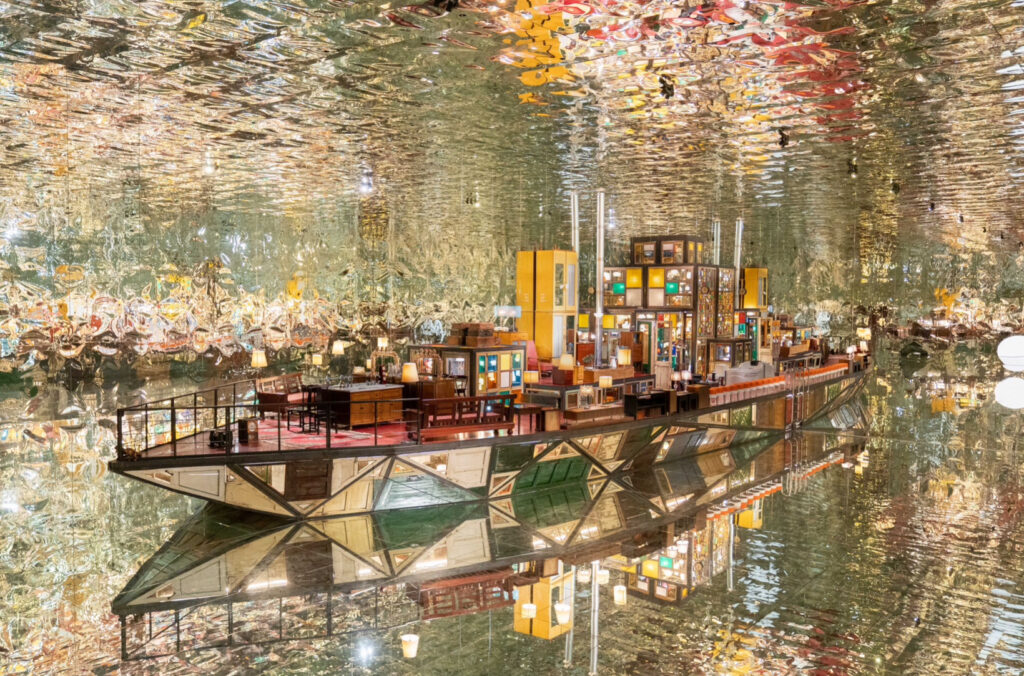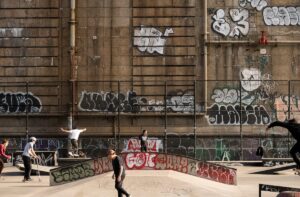
The world of Song Dong’s A Quarter is not entered—it is absorbed. Like a memory that unfolds without announcement, the installation invites viewers into a realm suspended between domestic nostalgia and conceptual inquiry. Situated within the expansive mirrored chamber of the Ennova Art Museum in Langfang, China, the work is both monumental and minuscule, familiar and surreal. Spanning years of conceptual evolution from 2021 to 2024, A Quarter is not merely an art installation; it is an emotional and architectural ecosystem—a landscape of interiors that reflect not just space, but psyche.
Constructed from steel, mirrors, collected daily objects, furniture, lighting fixtures, small stools, and carpets, Song Dong’s work is a meditation on domesticity, displacement, and the persistent residue of human presence. The mirrored surface—floor and ceiling—does more than duplicate the space; it transforms it into a liminal continuum, where reflection and reality merge so seamlessly that orientation itself becomes an emotional metaphor.
Materials as Memory: The Poetics of the Familiar
To catalog the materials used in A Quarter—steel scaffolding, repurposed wood, old lamps, weathered chairs—is to do it a quiet disservice. Because Song Dong doesn’t simply assemble things; he reanimates them. Each object within the installation carries the aura of its former life, as if the rooms they once occupied still echo faintly inside them.
The furniture is not staged as sculpture, but lived-in, layered—worn carpets bleed into wooden floorboards, cabinets cluster like urban tenements, dining sets unfold into spontaneous libraries of memory. There is no uniformity, no clean finish. Instead, there is the persistence of real life, where clutter isn’t chaos, but a register of presence. Even the small stools—simple, humble, essential—suggest the rhythm of daily ritual: of meals, of pause, of conversation unremarkable yet indispensable.
These elements create not a house, but a neighborhood in miniature. One does not view A Quarter so much as one is engulfed by it—wandering between constructed rooms and mental corridors that mirror the logic of dreaming: continuous, shifting, unresolved.
Mirrors and Multiplication: A Theater of Echoes
Perhaps the most arresting visual aspect of the installation is its use of mirrors. The floor and ceiling are fully mirrored, dissolving the idea of ground and sky. The room becomes a box of infinite repetitions—each chair, lamp, and cupboard duplicated endlessly in vertiginous perspectives. This vertigo is intentional. It is a metaphor for memory’s refusal to be linear.
In this mirrored chamber, there is no beginning or end. You are both inside and outside, above and below, subject and spectator. The reflection is not a duplication of space but a multiplication of emotion. The ceilings drip like water surfaces above a dreamscape. The floor becomes a glass lake, where every object floats and every human presence is untethered.
Song Dong’s choice to render the floor and ceiling indistinguishable acts as a philosophical query: Is memory grounded? Or does it float, like light across water, never touching what it reflects?
The Boat Form: Domesticity Adrift
The core architectural element within A Quarter resembles a floating barge or ship, structured from the skeletal lines of metal yet populated entirely by household items. This floating construct becomes the visual and emotional anchor of the work—a vessel of memory, part ark, part apartment block, part unconscious driftwood.
Yet this ship is not at sea. It floats on the still waters of mirrored perception, a surreal contradiction of stability and instability. It offers no forward motion, only infinite reflection. We are looking at a home adrift, a metaphor not only for migration or diaspora but for the fluidity of identity itself in the modern world.
The boat’s patchwork siding is assembled from reclaimed doors and panels—a mosaic of boundaries, openings, partitions. Each panel whispers a different domestic story, and yet, as part of this vessel, they share the same current. It is not a singular home, but a collective one—an ark not of salvation, but of remembrance.
The Lighting Within: Warmth Among Chaos
Amidst the cold reflectivity of the mirrored chamber, the presence of warm lighting fixtures is a critical counterpoint. Scattered lamps cast golden hues upon faded upholstery and polished wood grain. These lights do not just illuminate; they temper the surrealism with a fragile, glowing intimacy. It feels less like an installation and more like a place where someone just left the room, or is perhaps waiting to return.
The use of domestic lighting grounds the viewer emotionally, suggesting quiet routines: bedtime stories, early morning solitude, the rustle of a newspaper under lamplight. In the otherwise expansive illusion of endlessness, the lamps act as emotional hearths, stabilizing islands in an ocean of dislocation.
Cultural and Political Echoes
Song Dong’s practice has always moved between the personal and the political, the individual and the collective. In A Quarter, he channels these tensions through form and repetition rather than overt narrative. There is no signage, no didactics, no prescribed path—only the density of lived experience, reconstructed through humble things.
Yet the political murmurs under every surface. The use of collected daily objects—especially within a Chinese context—invokes the cycles of displacement, demolition, and urban reconstruction. This work could be a monument to the fast-erased hutongs of Beijing, to the generational loss beneath modernization, to the shifting thresholds between private and public life.
And in today’s China—where domestic stability can feel increasingly fragile under political tension—Song Dong offers not a protest, but a space of quiet resistance: a memory palace too mirrored to be erased, too intimate to be ignored.
Interactivity Without Interaction: The Ghost in the Installation
Unlike immersive environments that rely on interactivity or audience movement, A Quarter does not demand touch or activation. It sits still, omnipresent, asking you to slow down and look longer. In this stillness lies its power. Viewers don’t animate the work; they haunt it.
As one wanders through the mirrored corridors and boatlike structures, the feeling arises that one is walking through someone else’s dream. Or perhaps one’s own. The absence of figures becomes its own presence. There are chairs, but no sitters. Lamps, but no readers. Beds, but no sleepers. And yet, every surface feels recently vacated. The installation lives in this uncanny space of recentness without presence, like memory itself.
A Personal Cosmology: Song Dong’s Legacy
“Waste Not,” Song Dong’s seminal work composed of his late mother’s hoarded household items, showed us that emotion lives in accumulation. In A Quarter, that lesson has matured. Here, we don’t see a single personal archive—we see a shared mnemonic language made from the syntax of furniture, light, and mirrored time.
Song Dong continues to construct cosmologies from the domestic. His work, like that of Louise Bourgeois or Rachel Whiteread, understands that the emotional weight of the home is both physical and psychic. In A Quarter, he extends this philosophy across time and scale, from the intimacy of a wooden stool to the infinite mirroring of the universe.
Impression
Song Dong’s A Quarter does not tell a story. It accumulates it, like dust on a bookshelf, like light on an old rug. It does not offer resolution or arc, but persistence—the stubborn, glorious act of living remembered in fragments.
It is not a house, but an act of housing. Not a boat, but the condition of floating. Not a mirror, but the ritual of reflection. And in that, it becomes not only art, but a quiet emotional architecture—a place where viewers might remember something they’d long forgotten, or invent something they never had.
In this installation, Song Dong doesn’t show us how we live.
He shows us how we remember living.
No comments yet.








